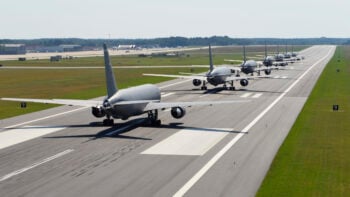
[UPDATED 2:10 pm with comment from President Obama & Pentagon spokesman Kirby] Western media are hardly going easy on Russia. But in all the often-excellent coverage I’ve read so far of the Malaysian Airlines Flight 17 disaster – which claimed 295 lives – no one* is pointing out two basic facts that point towards Russia and its separatist proxies:
1) MH17 was flying eastwards.
2) The Russian-backed rebels don’t have an air force.
For our latest on the Ukraine crisis and Malaysian Airlines Flight 17, read MH17 Tragedy Strengthens European Spines To Sanction Russia: UK Ambassador
Both these factors make it extremely unlikely Ukrainian government forces shot down the airliner. It’s not that Ukrainian troops are incapable of such a horrific mistake: They accidentally shot down a Russian jetliner during a military exercise in 2001, killing 78 people, and frankly the Ukrainian military’s skills have only degenerated since. Even the well-trained US Navy shot down an Iranian airliner in 1988, killing 290, because, amidst high tensions in the Gulf, the USS Vincennes mistook the approaching airliner for an attack plane.
But context matters. First, from a Ukrainian perspective, MH17 was flying from friendly, government-controlled territory towards rebel-held territory and Russia. That outbound vector would make it much harder for an anxious, trigger-happy Ukrainian air defense officer to mistake it for an incoming attack. From the perspective of a separatist or Russian gunner, however, MH17 was inbound from enemy territory.
Second, Ukrainian air defenses haven’t been shooting at anything so far this war because they haven’t had anything to shoot at. Russia has given the separatists weaponry, even rocket launchers and main battle tanks, but the rebels still don’t have aircraft. Russia itself does, of course, and Kiev claims a Russian aircraft shot down a Ukrainian Su-25 fighter Wednesday, so Ukrainian air defense units probably are now watching the skies more nervously than before (although, again, they would be watching for aircraft flying westwards).
But Russian-backed separatists have an actual track record of shooting down Ukrainian government aircraft, including a large-bodied AN-26 transport. A Ukrainian military AN-26 doesn’t look particularly like a Malaysian Airlines Boeing 777: It’s much smaller, with straight wings and propellers, in contrast to the larger, swept-wing jet. But the two look much more like each other than either looks like, say, a fighter plane, especially on radar where details of shape would be obscured. And, notoriously, a separatist commander (and suspected Russian operative) known as Col. Igor Strelkov tweeted a claim the rebels had shot down an AN-26 just after MH17 crashed – a post later deleted.
If rebel forces did fire the fatal missile, however, their regular shoulder-launched weapons couldn’t have reached the high-altitude airliner: They would have had to use a more sophisticated anti-aircraft system such as the Russian-made Buk (in English, “Beech”; NATO codenames “SA-11 Gadfly” and “SA-17 Grizzly” depending on the variant). AP reporters have seen a Buk in rebel hands, and the rebels themselves claimed to have captured one from Ukrainian government forces. With ex-Soviet, ex-Ukrainian, and ex-Russian military personnel in their ranks, it’s quite possible they had enough former air defense troops to get the Buk working – although they would not have had a supporting infrastructure of command, control, and sensor networks to help them distinguish hostile from friendly aircraft.
It is also possible that Russian operatives sent by Moscow were working the advanced equipment on the rebels’ behalf. I personally think it unlikely (not impossible) that the highly centralized Russian military would have opened fire by accident – but personnel loaned to the Ukrainian separatists would be operating outside the usual safeguards.
[UPDATE: At a press conference this afternoon, the Pentagon’s top spokesman, Rear Adm. John Kirby, demurred on most questions about the tragedy, citing the ongoing investigation, but he did make some blunt statements.
“The SA-11 [missile], the one we believe was used to down Flight 17, is a sophisticated piece of technology,” Kirby said. “It strains credulity to think it could be used by separatists without at least some measure of Russian support and technical assistance.”
That could include the training of separatists on “vehicle-borne” anti-aircraft systems, which European Command chief Gen. Philip Breedlove has said has already happened on Russian soil. Or it could be Russian personnel working for or with the separatists. “We don’t know,” said Kirby.
But the US is now confident that the missile that downed MH-17 was fired from separatist-controlled territory, Kirby said — a statement so damning that I felt compelled to email the admiral to confirm I heard it correctly (he said I had). President Barack Obama said the same thing.]
Those of us – myself included – who have long been suspicious of Putin’s Russia should be careful not to rush to judgment. But the circumstantial evidence so far makes it highly unlikely the blame falls on Ukraine.
The analysis in this article represents my personal judgment and not any official position of Breaking Defense. — Sydney J. Freedberg Jr.
* Update: After I wrote this story, Center for Strategic & International Studies (CSIS) analyst Tony Cordesman mentioned the flight-path issue in a blog post. Cordesman’s in-depth technical and tactical expertise make his analysis well worth reading.
Army inching towards late FY25 Chinook Block II full-rate production contract
Boeing recently announced the Block II helo’s first maiden flight and plans to deliver the first production aircraft to the service in the coming weeks.


























